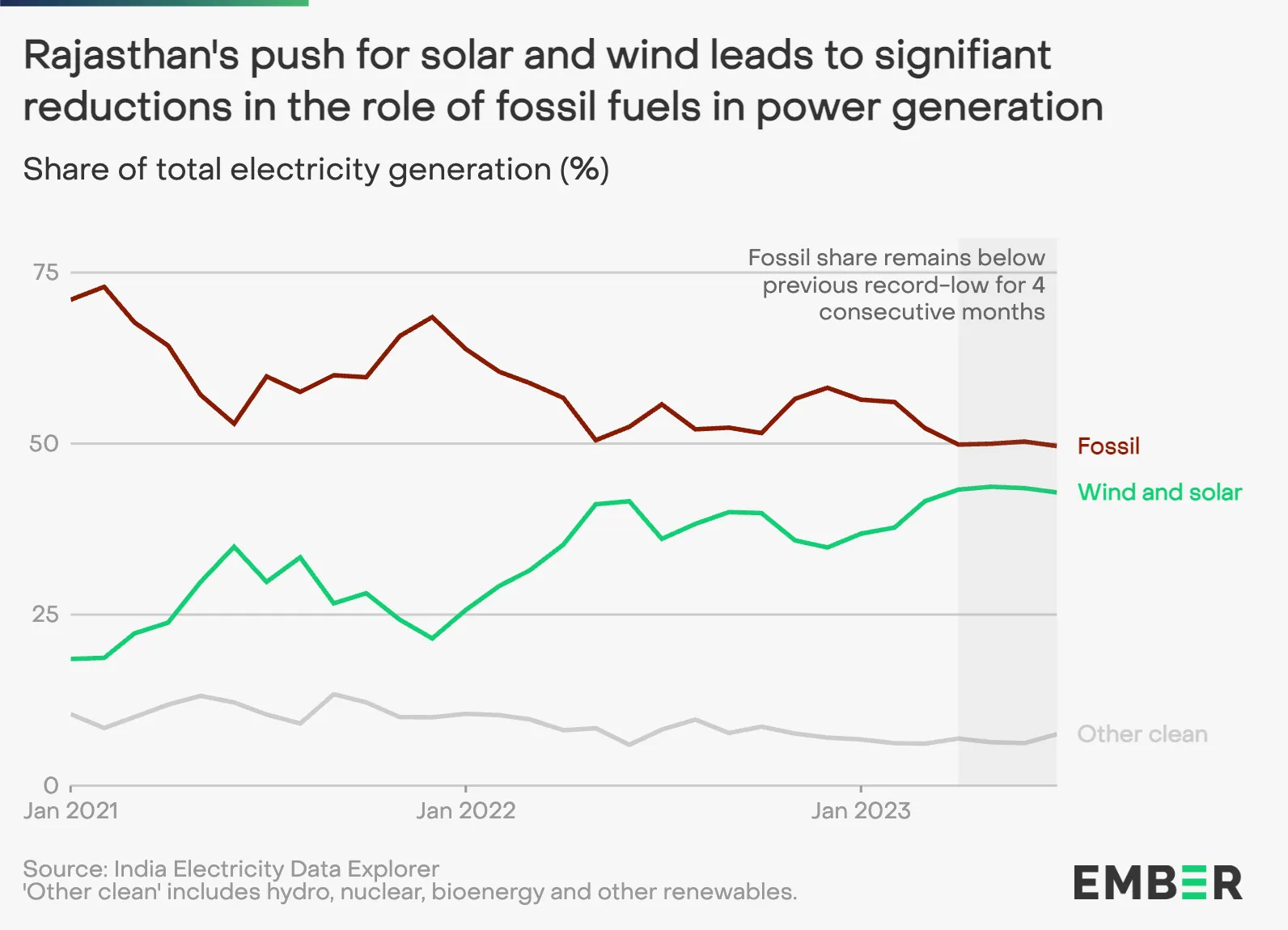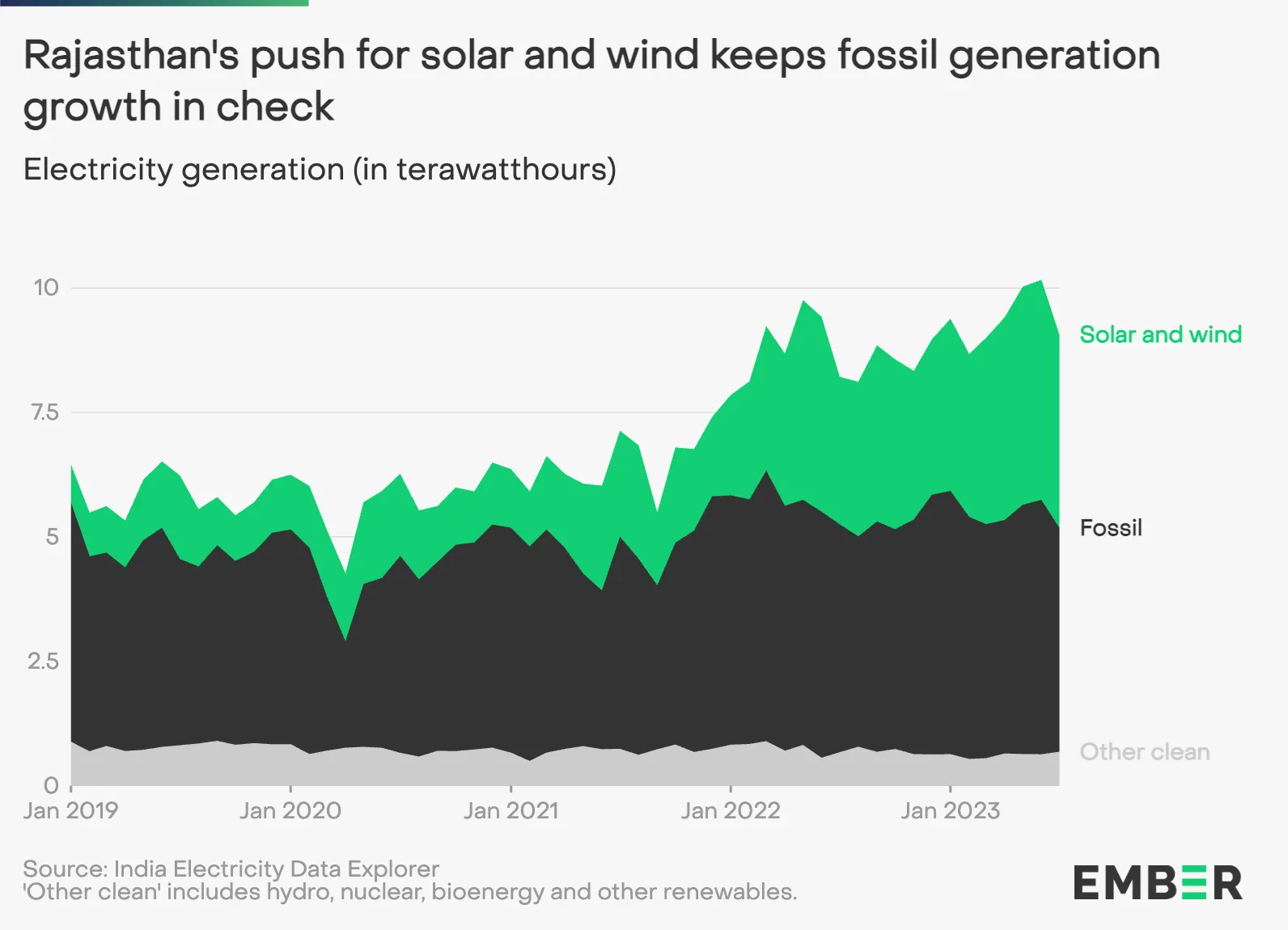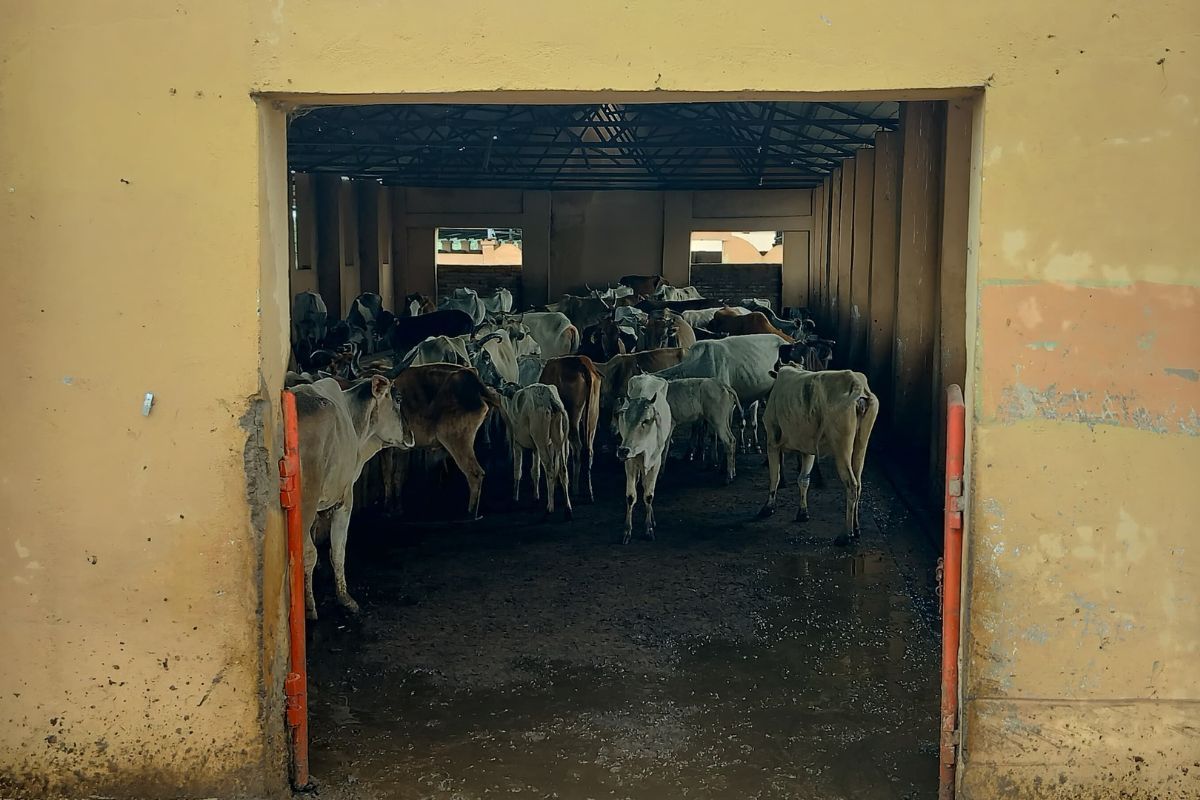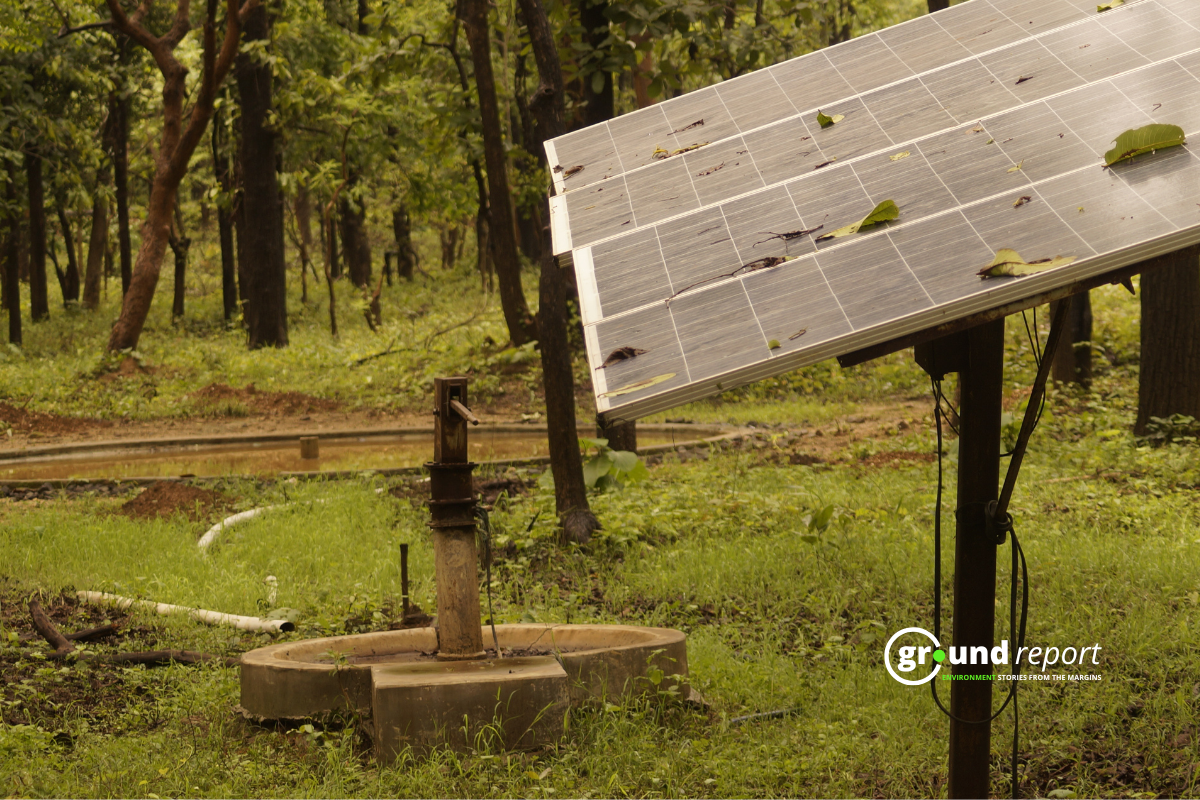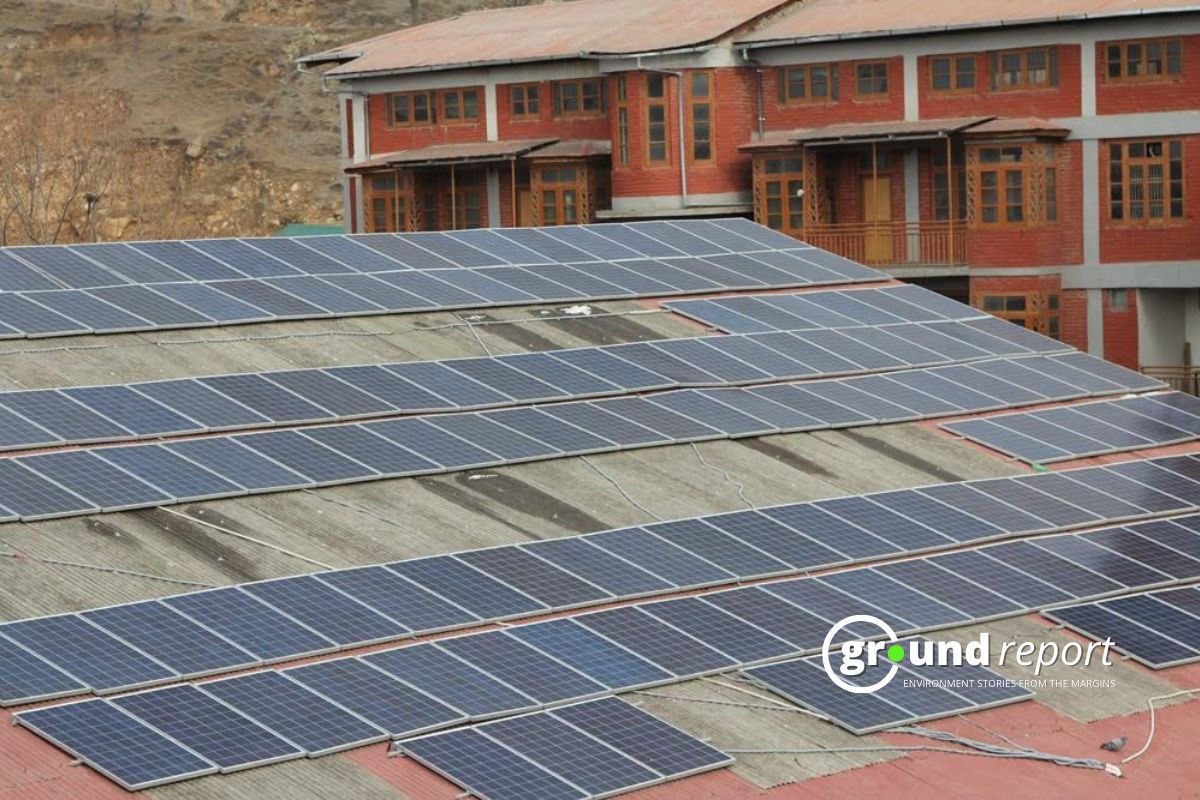New data from global energy think tank Ember reveals that the share of fossil fuels in Rajasthan’s power generation mix has hit record-low levels at 50% from April to July. This is the first time that the lowest level was sustained for over a quarter of the year.
Solar and wind power surge in Rajasthan
Fossil fuels produced 34 TWh of electricity from January to July 2023, showing no growth (-1.6%) in comparison to the same period in 2022. Meanwhile, solar and wind power generation grew 28% year-on-year, having produced 27 TWh in the same period this year.
Just two years ago, solar and wind generation would have been less than half of the amount we see today. Combined with other clean sources (nuclear, hydro, bioenergy), clean power generation in Rajasthan is now on par with fossil generation.
From January to July 2023, electricity generation in Rajasthan increased by 4.4 TWh compared to the same period in 2022. The increase in power generation was entirely fuelled by growth in solar and wind. As a result, the carbon emissions intensity of power produced in Rajasthan in July 2023 was 422 gCO2e/kWh, 10% lower than in July 2022.
The state of Rajasthan has pushed for deployment of solar and wind power fleets by administering its Solar Energy Policy and Wind Hybrid Energy Policy in 2019. In addition, the rise in demand for clean power in other states such as Delhi is attracting investments in Rajasthan, a state that boasts the highest solar potential across the country.
Fossil fuel generation in Rajasthan
| Generation_date | Fossil | Other clean | Solar and wind |
|---|---|---|---|
| 2019-01 | 74.51 | 13.71 | 11.79 |
| 2019-02 | 71.33 | 12.68 | 16.00 |
| 2019-03 | 69.12 | 14.24 | 16.65 |
| 2019-04 | 69.23 | 13.09 | 17.67 |
| 2019-05 | 68.56 | 11.74 | 19.69 |
| 2019-06 | 67.56 | 11.99 | 20.46 |
| 2019-07 | 60.03 | 13.06 | 26.92 |
| 2019-08 | 63.97 | 15.30 | 20.74 |
| 2019-09 | 67.76 | 15.57 | 16.68 |
| 2019-10 | 68.05 | 15.14 | 16.80 |
| 2019-11 | 67.48 | 15.04 | 17.47 |
| 2019-12 | 69.10 | 13.55 | 17.35 |
| 2020-01 | 69.03 | 13.36 | 17.61 |
| 2020-02 | 68.86 | 10.59 | 20.55 |
| 2020-03 | 60.31 | 13.71 | 25.98 |
| 2020-04 | 50.06 | 17.91 | 32.03 |
| 2020-05 | 57.40 | 13.74 | 28.86 |
| 2020-06 | 57.63 | 12.87 | 29.50 |
| 2020-07 | 63.12 | 10.56 | 26.32 |
| 2020-08 | 64.33 | 10.63 | 25.04 |
| 2020-09 | 67.58 | 12.49 | 19.93 |
| 2020-10 | 69.19 | 11.61 | 19.20 |
| 2020-11 | 70.32 | 12.33 | 17.35 |
| 2020-12 | 69.06 | 11.78 | 19.16 |
| 2021-01 | 71.01 | 10.46 | 18.53 |
| 2021-02 | 72.90 | 8.43 | 18.68 |
| 2021-03 | 67.69 | 10.04 | 22.26 |
| 2021-04 | 64.32 | 11.85 | 23.83 |
| 2021-05 | 57.11 | 13.13 | 29.76 |
| 2021-06 | 52.90 | 12.17 | 34.92 |
| 2021-07 | 59.81 | 10.40 | 29.78 |
| 2021-08 | 57.54 | 9.09 | 33.37 |
| 2021-09 | 59.98 | 13.37 | 26.65 |
| 2021-10 | 59.69 | 12.18 | 28.13 |
| 2021-11 | 65.71 | 10.03 | 24.26 |
| 2021-12 | 68.48 | 10.00 | 21.52 |
| 2022-01 | 63.80 | 10.51 | 25.69 |
| 2022-02 | 60.48 | 10.31 | 29.20 |
| 2022-03 | 58.84 | 9.70 | 31.47 |
| 2022-04 | 56.68 | 8.11 | 35.22 |
| 2022-05 | 50.48 | 8.40 | 41.13 |
| 2022-06 | 52.45 | 5.98 | 41.57 |
| 2022-07 | 55.72 | 8.20 | 36.07 |
| 2022-08 | 52.08 | 9.67 | 38.26 |
| 2022-09 | 52.32 | 7.70 | 39.98 |
| 2022-10 | 51.53 | 8.63 | 39.84 |
| 2022-11 | 56.53 | 7.62 | 35.85 |
| 2022-12 | 58.15 | 7.03 | 34.81 |
| 2023-01 | 56.41 | 6.76 | 36.83 |
| 2023-02 | 56.06 | 6.21 | 37.73 |
| 2023-03 | 52.26 | 6.15 | 41.58 |
| 2023-04 | 49.85 | 6.89 | 43.27 |
| 2023-05 | 49.97 | 6.35 | 43.69 |
| 2023-06 | 50.29 | 6.23 | 43.48 |
| 2023-07 | 49.63 | 7.53 | 42.85 |
Rajasthan leads in clean energy
From January to July 2023, Rajasthan added 1.7 GW of solar and 0.5 GW of wind capacity. As of July 2023, Rajasthan’s solar and wind capacity stood at 23 GW, accounting for 20% of India’s solar and wind capacity.. Expansion of solar and wind has made Rajasthan a top supplier of clean electricity in India. Meanwhile, fossil generation capacity – coal and gas – showed no change since 2022.
As a nation, India generated over 70% of its electricity from fossil fuels throughout 2023 (up to July), and 77% of its electricity across the whole of 2022.
Ember’s Data Analyst, Uni Lee, said, “To limit global temperature rise to 1.5C, it is imperative that the world must triple renewable capacity by 2030. The G20 countries have committed to meeting this goal under India’s presidency.
The remarkable growth in renewables in Rajasthan demonstrates that it is possible. India can lead by example through successful delivery on President Modi’s promise to reach 500 GW of non-fossil generation capacity.
Support us to keep independent environmental journalism alive in India.
Keep Reading
Part 1: Cloudburst in Ganderbal’s Padabal village & unfulfilled promises
India braces for intense 2024 monsoon amid recent deadly weather trends
Follow Ground Report on X, Instagram and Facebook for environmental and underreported stories from the margins. Give us feedback on our email id greport2018@gmail.com.
Don’t forget to Subscribe to our weekly newsletter, Join our community on WhatsApp, and Follow our YouTube Channel for video stories.

